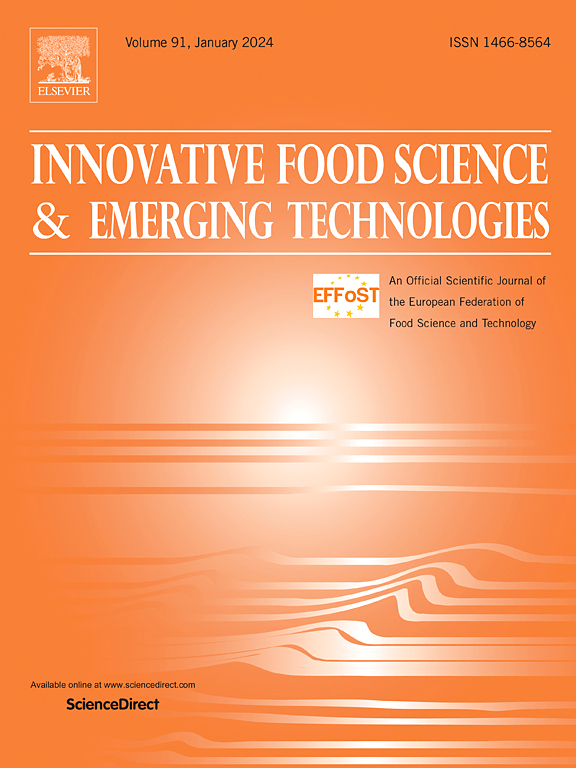Starch-based hydrogels produced by high-pressure processing (HPP): The effect of high pressure on volume changes
IF 6.3
1区 农林科学
Q1 FOOD SCIENCE & TECHNOLOGY
Innovative Food Science & Emerging Technologies
Pub Date : 2025-04-08
DOI:10.1016/j.ifset.2025.104024
引用次数: 0
Abstract
The transformation of a solution into a gel, known as the sol-gel transition, can be observed in a variety of systems, such as colloidal suspensions, polymers, and biomolecules. Among them, starch, a plant-derived polysaccharide, undergoes sol-gel transition when subjected to different processing conditions, displaying intriguing rheological characteristics. This work aimed to investigate the mechanism of pressure-inducted gelatinization, with a particular focus on the impact of high pressure on volume changes. The investigation was carried out using different starches, namely rice, corn, and wheat dissolved in water at a constant concentration of 20 % w/w. The starch solutions underwent HPP, and the treatment conditions used were high pressures in the range of 500–700 MPa and holding times between 5 min and 15 min. The volume changes were assessed by using differential scanning calorimetry (DSC) and microscopy techniques. The results obtained showed that, regardless of the starch source and the evaluation method used, the volume changes, related to the partial molar volume of a polymer in a solvent, had negative values (−12.63 − −35.83 mL/mol) and decreased with increasing the pressure level. As a result, it can be suggested that when the amorphous and crystalline regions of the granules were hydrated under pressure, producing the swelling of starch granules, the partial volume of starch decreased due to molecular-level rearrangements or interactions occurring within the starch granules during the sol-gel transition. This study provides valuable insights into the fundamental mechanisms of pressure-induced starch gelatinization, which could pave the development of more stable, functional, and efficient products where controlled texture and consistency are critical.

高压加工淀粉基水凝胶(HPP):高压对体积变化的影响
溶液向凝胶的转变,称为溶胶-凝胶转变,可以在各种系统中观察到,如胶体悬浮液、聚合物和生物分子。其中淀粉是一种植物源性多糖,在不同的加工条件下会发生溶胶-凝胶转变,表现出有趣的流变特性。这项工作旨在研究压力诱导糊化的机制,特别关注高压对体积变化的影响。采用不同的淀粉,即水稻、玉米和小麦,以20% w/w的恒定浓度溶于水中。将淀粉溶液进行HPP处理,处理条件为500-700 MPa的高压,保温时间为5分钟至15分钟。通过差示扫描量热法(DSC)和显微镜技术评估体积变化。结果表明,无论淀粉来源和评价方法如何,聚合物在溶剂中的偏摩尔体积变化均为负值(- 12.63 ~ - 35.83 mL/mol),且随压力水平的增加而减小。结果表明,当淀粉颗粒的非晶态和晶态区域在压力下水化,产生淀粉颗粒的膨胀时,由于在溶胶-凝胶转变过程中淀粉颗粒内部发生分子水平的重排或相互作用,淀粉的部分体积减小。这项研究为压力诱导淀粉糊化的基本机制提供了有价值的见解,这可以为开发更稳定,功能和高效的产品铺平道路,其中控制质地和稠度是至关重要的。
本文章由计算机程序翻译,如有差异,请以英文原文为准。
求助全文
约1分钟内获得全文
求助全文
来源期刊
CiteScore
12.00
自引率
6.10%
发文量
259
审稿时长
25 days
期刊介绍:
Innovative Food Science and Emerging Technologies (IFSET) aims to provide the highest quality original contributions and few, mainly upon invitation, reviews on and highly innovative developments in food science and emerging food process technologies. The significance of the results either for the science community or for industrial R&D groups must be specified. Papers submitted must be of highest scientific quality and only those advancing current scientific knowledge and understanding or with technical relevance will be considered.

 求助内容:
求助内容: 应助结果提醒方式:
应助结果提醒方式:


